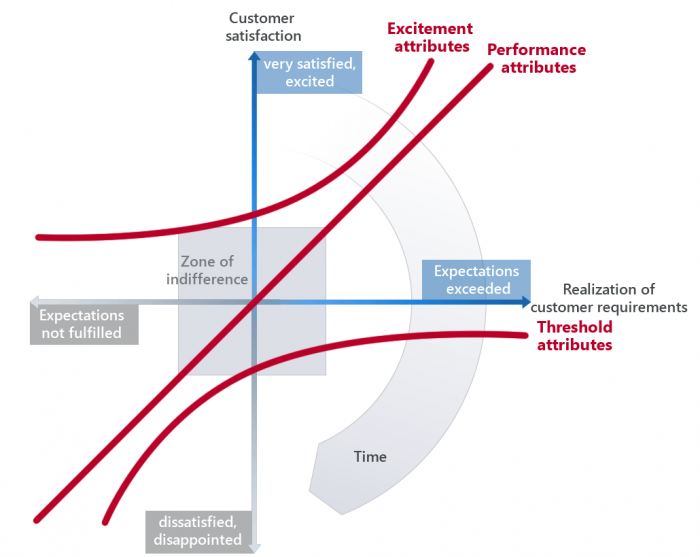The Kano Model
 Graphics courtesy of Shmula.comOpens in new window
Graphics courtesy of Shmula.comOpens in new window
The Kano model, named after Noriaki Kano of Japan, provides a useful method of answering the question of whether measures for increasing product quality have an effect on customer satisfactionOpens in new window. |
The Kano model is based on the idea of dividing customer standards of company performance according to basic, performance, and thrill standards (Hermann, Huber & Braunstein, 2000, p. 47).
Basic Standards (Must Be)
Basic standards embody criteria which a product absolutely must fulfill. If the offered service does not satisfy these criteria, the customer will be dissatisfied. If the person receiving the service sees these expectations as having been fulfilled, he does not express satisfaction, but is merely not dissatisfied with the product.
The providing of a vehicle registration document, as part of the purchasing of a new vehicle via a dealer, can serve as a typical example of a basic standard.
If the purchaser of an s-class car from Daimler Chrysler had to go all the way to the place of registration, in order to register the car there, the dealer and manufacturer could hardly be surprised if this were experienced by the customer as a dip in his level of satisfaction.
Another example of a basic standard is the airbag. However, its presence does not promote satisfaction, only avoids dissatisfaction. If a car manufacturer leaves this feature out, it will have to deal with annoyed customers, or the loss of business.
Performance Standards (One-dimensional)
With the performance standard, satisfaction is proportionate to the level of fulfillment. The higher the level of fulfillment, the more satisfied, and vice versa. Performance standards are generally explicitly expected by the customer.
With cars this could mean the ability to accelerate, and with personal computers, this would entail memory capacity. Performance standards are features that the customers will always want to constantly improve.
Thrill Standards (Attractive)
Thrill standards are those product criteria which have the highest influence on customer satisfaction with a product. They are not explicitly formulated by the customer and are also not expected.
Fulfilling these standards leads to an overflowing of customer satisfactionOpens in new window. If these standards are not fulfilled there is no feeling of dissatisfaction.
A purchaser of a personal computer, for example, would react with surprise if a dealer proceeded to install the software as part of the purchase, without charging extra.
A customer might also be thrilled by the prospect of arriving at her car loaded down with shopping bags, and not having to put these bags down onto a possibly wet ground, to search for her car key, because the doors of the car have already opened via a remote signal.
What customers experience as basic, performance, and thrill standards depend on their prevailing preferences, and therefore they often differ from customer to customer.
Moreover the classification changes with time. What thrills customers today, will be explicitly expected tomorrow, and the day after tomorrow the same performance feature will be seen as basic, and taken for granted.
Advantages of the Kano Model
The advantages of the classification of customer standards according to the Kano model are as follows (Berger, Blauth & Boger, 1993):
- Better understanding of product standards: those criteria can be identified which have the greatest influence on customer satisfaction.
- From the classification of product standards in basic, performance, and thrill standards, priorities for product development can be derived. For example, it is far less meaningful to invest in the further development of basic standards, when these have already been satisfactorily fulfilled, than it is to invest in the improvement of performance or thrill standards, which have a bigger influence on the perception of product qualityOpens in new window, and therefore also on customer satisfactionOpens in new window.
- The Kano method delivers a helping hand with trade-offs in product development. If two product features cannot be simultaneously fulfilled for technical or financial reasons, those criteria which have greater effect on customer satisfaction can be identified.
 Figure X-1: The Kano Model
Figure X-1: The Kano ModelCredit: microTOOLOpens in new window |
- In general, basic, performance, and thrill standards differ according to the expectations of benefits for varying segments of the customer population. On this basis, custom-made performance packages can be developed for focused problem solving, which guarantee an optimal level of satisfaction for the various segments.
- The discovery and fulfillment of thrill standards offers many possibilities for differentiation. A product which merely fulfills the basic and performance standards, is perceived as average and therefore exchangeable (Hinterhuber, Aichner & Lobenwein, 1994).
- The Kano model of customer satisfaction can be combined with QFD, is more precisely defined hereOpens in new window. A prerequisite here is the identification of customer needs, of their ranking and priority. (Handlbauer, 1995, pp. 263 – 284).
In particular, the importance of individual product characteristics for customer satisfaction is discovered through the utilization of the Kano model, and thereby an optimized precondition for product development activity is attained.
The Course of a Kano Project
Before designing the actual Kano questionnaire it is necessary to find out the relevant standards from the perspective of the customer. To that end there are various methods, like for example, the analysis of complaints, discussions with the customer, or focus group interviews.
Studies of Griffin & Hauser have here shown that 20 – 30 qualitative customer interviews in homogenous segments are enough, in order to find out over 90 percent of all desired product standards (Griffin & Hauser, 1994, pp. 1 – 27).
After the product and performance features relevant to the customer have been ascertained, the Kano questionnaire can be designed.
Kano devised two special question types with five possible answers, in order to filter out the relevant basic, performance, and thrill product features.
| Kano’s Formulated Questionnaire | |
|---|---|
Functional Form of the QuestionHow would you like it, if the contact people were always available? |
|
Dysfunctional Form of the QuestionHow would you like it, if the contact people were not always available? |
|
The first question refers to the reaction, if the relevant product feature (functional form of the question) is present, the second refers to the reaction, if the relevant product feature is not present (dysfunctional form of the question).
Via the combination of the answers to both questions, the product standards can be classified, by means of specific evaluation procedures.
A hierarchy of product or service standards is clearly observable: basic standards come before performance standards, which come before thrill standards. If a company lacks necessary competencies with regard to basic standards, it needs to be determined how fast these can be developed, or if they can be purchased.
In addition to the Kano questions, it is advisable to get the customer to assess the different criteria of his current product, as well as to gather the relative significance of the individual criteria (on a scale of from ‘very important’ to ‘totally unimportant’).
In the evaluation of data, the Kano method falls back on the satisfaction inducing coefficient. This coefficient provides information about how securely the product feature is in the position to increase satisfaction, or conversely, how negatively satisfaction would be affected in the event that this product feature was not being fulfilled. In it, the number of classifications into basic, performance, and thrill standards, as well as product characteristics to which the customer is indifferent, are for a product feature combined into a mathematical relationship.
The measure of dissatisfaction is appended by a negative sign, which illustrates that the non-fulfillment of a promised or expected service induces dissatisfaction. The positive satisfaction coefficient ranges from 0 to 1.
The closer the value is to 1, the more influence on satisfaction is positive. If the value is close to – 1, this means that very many of the people asked were unhappy with the service. A value near 0 signifies that if this feature is not fulfilled, it produces hardly any movement toward dissatisfaction.

